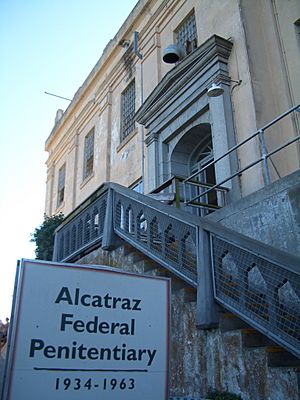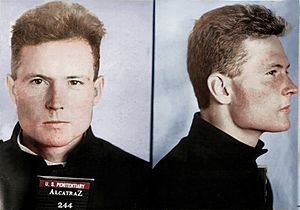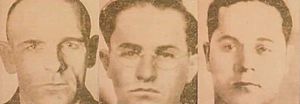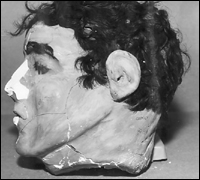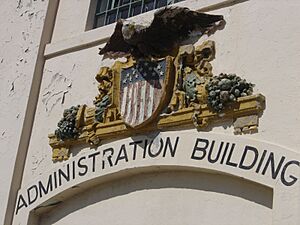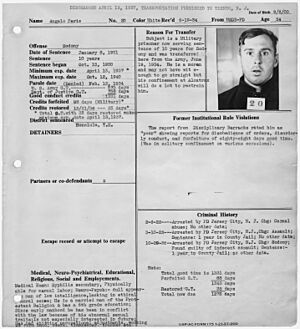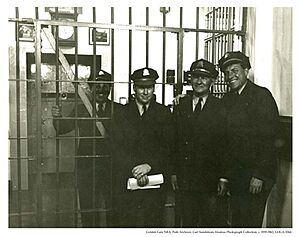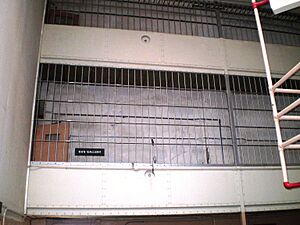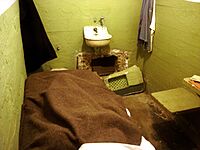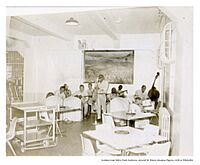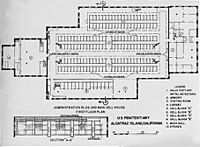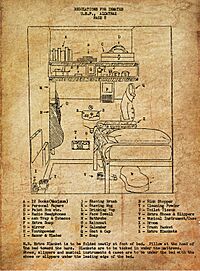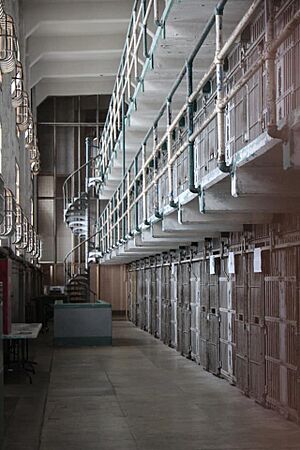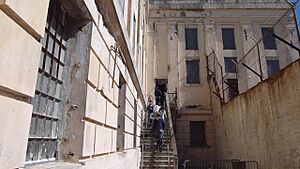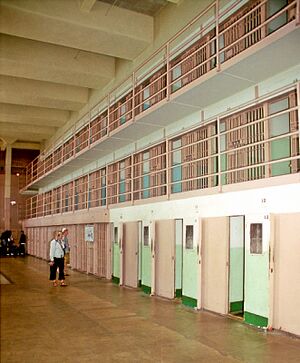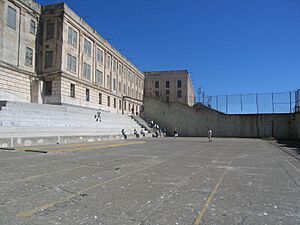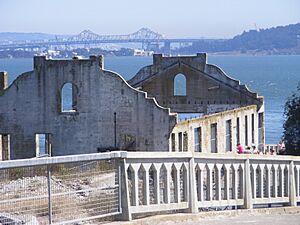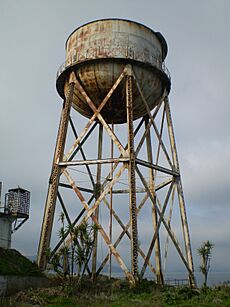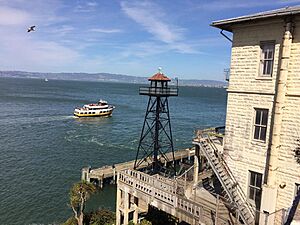Alcatraz Federal Penitentiary facts for kids
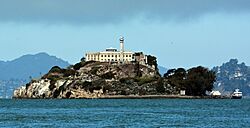
The prison sits atop Alcatraz Island, 2013
|
|
| Location | San Francisco Bay, California, U.S. |
|---|---|
| Coordinates | 37°49′36″N 122°25′23″W / 37.82667°N 122.42306°W |
| Status | Closed (now a museum) |
| Security class | Maximum |
| Capacity | 336 |
| Opened | August 11, 1934 |
| Closed | March 21, 1963 |
| Managed by | Federal Bureau of Prisons, Department of Justice |
| Director |
Edwin B. Swope (1948–1955) Paul J. Madigan (1955–1961) Olin G. Blackwell (1961–1963) |
Alcatraz, also known as "The Rock," was a famous high-security federal prison. It was located on Alcatraz Island, about 1.25 miles (2.01 km) off the coast of San Francisco, California. The island had been a fort since the 1850s. The main prison building was first built between 1910 and 1912 for the U.S. Army.
The United States Department of Justice took over Alcatraz in 1933. It became a federal prison in August 1934 after being updated with better security. Because of its strong security and its location in the cold, strong currents of San Francisco Bay, many believed Alcatraz was impossible to escape from. It was thought to be America's most secure prison.
The prison building had three floors with four main cell blocks. It also had the warden's office, a visiting room, a library, and a barber shop. The cells were small, usually 9 feet by 5 feet and 7 feet high. They were simple, with a bed, a desk, a washbasin, and a toilet. Prisoners had little privacy. Some prisoners with serious behavior problems were sent to special cells called "The Hole" in D-Block. The dining hall and kitchen were connected to the main building. Prisoners and staff ate meals together. The Alcatraz Hospital was located above the dining hall.
Working at the prison was a special privilege for inmates. Those who earned this privilege worked in buildings like the Model Industries Building and New Industries Building. They helped the military by sewing, doing woodwork, and performing other tasks like laundry.
Alcatraz prison closed in 1963. However, it reopened as a public museum. From 1969 to 1971, Native American groups occupied the island. Today, Alcatraz is a major tourist spot in San Francisco. About 1.5 million people visit it every year. The National Park Service now manages the former prison, working to restore and maintain its historic buildings.
Contents
History of Alcatraz
Building the Prison
The main prison building used parts of an old fort from 1859. This fort had been used as a jail during the American Civil War for people thought to be against the Union. A new concrete prison building was constructed between 1910 and 1912. It cost about $250,000. When it was finished, the 500-foot-long building was said to be the longest concrete building in the world. This building was updated in 1933 and 1934 to become the federal prison. It closed in 1963.
When the new prison was built, many old materials were reused. Iron staircases and a cellhouse door from the old fort were kept. Large granite blocks, once used for cannons, became parts of the wharf. Many old cell bars were used to make the walls stronger. However, some of these bars near the edges rusted over time because of the salty air.
After the United States Army used the island for over 80 years, it was given to the Federal Bureau of Prisons. They hoped an escape-proof jail would help stop the rise in crime during the 1920s and 1930s. The Department of Justice took over Alcatraz on October 12, 1933. It became a federal prison in August 1934. About $260,000 was spent to modernize it. New security features were added, like metal detectors and improved locking systems.
Early Days of the Prison
Alcatraz was meant for prisoners who caused constant trouble in other federal prisons. It was a "last resort prison" for the most difficult inmates. On August 11, 1934, the first group of 137 prisoners arrived. They came from a prison in Leavenworth, Kansas. Most of these prisoners were famous bank robbers, counterfeiters, or murderers.
More prisoners arrived from other federal prisons in 1934 and 1935. By June 30, 1935, the prison had 242 inmates. The Bureau of Prisons stated that Alcatraz provided a secure place for dangerous criminals. It also helped improve discipline in other prisons.
Over time, the buildings on Alcatraz needed more work. A severe storm in 1935 caused a landslide, damaging one of the buildings. This led to more construction and improvements. In 1939–1940, a big renovation project costing $1.1 million began. This included building the New Industries Building, updating the power house, and adding a new water tower. These changes were finished in July 1941. During World War II, the workshops in the New Industries Building were very busy. Prisoners made Army uniforms and other important items.
Alcatraz's Reputation
From the start, Alcatraz was known as the toughest prison in the U.S. Many thought it was the most feared prison in the world. Some former prisoners said the conditions were very harsh and affected their mental health. One writer called Alcatraz "the great garbage can of San Francisco Bay."
The prison's reputation grew with the arrival of famous criminals. One was Robert Stroud, known as the "Birdman of Alcatraz," who arrived in 1942. He spent 17 years at Alcatraz. Stroud had been in prison since he was 19 and spent many years in solitary confinement. Despite its tough image, some prisoners said the food and living conditions were better than in other prisons. Many even volunteered to be sent to Alcatraz.
In 1940, an inmate named Henri Young was involved in a serious incident where another inmate was killed. Young had spent a long time in solitary confinement before this. The trial brought more attention to Alcatraz's harsh conditions.
The Final Years
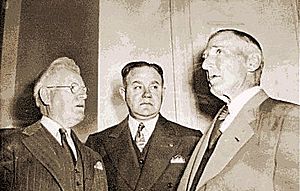
By the 1950s, conditions at Alcatraz had improved. Prisoners were allowed more privileges, like playing music, watching movies, painting, and using radios. The strict rule of silence became more relaxed. However, Alcatraz was still the most expensive prison to run in the United States.
A report in 1959 showed that it cost three times more to keep a prisoner at Alcatraz than at other prisons. The buildings were also falling apart due to the salty air. Fixing them would cost millions of dollars. Major repairs started in 1958, but by 1961, engineers thought the prison was beyond repair.
A famous escape attempt in June 1962 led to more investigations. Because of the high costs and structural problems, Alcatraz closed on March 21, 1963. The prison had served its purpose by holding the most difficult criminals.
Today, the former prison and island are a museum. It is a popular tourist attraction in San Francisco. Visitors can take a boat to the island and tour the cellhouse. They can also listen to stories from former inmates and guards. The old prison buildings are being restored and maintained by the National Park Service.
In 2025, there was a discussion about possibly reopening Alcatraz for dangerous offenders. However, experts noted that renovating and maintaining the prison would be very expensive.
Escape Attempts from Alcatraz
Prison officials always said that no prisoner ever successfully escaped from Alcatraz. During its 29 years, 36 prisoners made 14 escape attempts. Two men tried to escape twice. Of these, 23 were caught, six were shot and killed, and two drowned. Five others are listed as "missing and presumed drowned."
The first escape attempt happened on April 27, 1936. Joseph Bowers was burning trash when he tried to climb a fence. He was shot when he refused to come down and died from his injuries.
On December 16, 1937, Theodore Cole and Ralph Roe cut through window bars in a workshop. They climbed into the rough waters of the bay during a storm. They were never found, and authorities believed they drowned.
The Battle of Alcatraz
The most violent escape attempt happened from May 2–4, 1946. This event is known as the "Battle of Alcatraz." Six prisoners, including Bernard Coy, Joseph Cretzer, and Sam Shockley, tried to take over the cell house. They overpowered guards and got into the weapons room. They wanted keys to the outside recreation door to escape by boat.
A quick-thinking guard, William Miller, hid the key to the outer door. When the prisoners couldn't open the door, they decided to fight. They held Miller and another guard hostage. Two guards were killed during the battle. The U.S. Marines were called in and killed three of the prisoners. Shockley, Thompson, and Carnes were tried for the guards' deaths. Shockley and Thompson were sentenced to death, while Carnes received another life sentence.
The 1962 Escape
On June 11, 1962, Frank Morris, John Anglin, and Clarence Anglin made a very clever escape attempt. They chiseled away at the salt-damaged concrete around an air vent behind their cells. They used tools like a metal spoon and a homemade electric drill. The noise was hidden by music played during music hour. They covered their progress with fake walls that fooled the guards.
Their escape route led through a fan vent. They removed the fan and motor, creating a hole big enough to climb through. They also stole raincoats to make an inflatable raft. They prepared the raft on top of the cell block, hidden from guards. In their beds, they placed papier-mâché dummies with real human hair to make it look like they were sleeping. They escaped through a vent in the roof and left Alcatraz.
Another prisoner, Allen West, was part of the group but was left behind. His fake wall got stuck, and by the time he got out, his companions were gone. The FBI investigated for years, but found no clear proof if the men survived or not. The official report said the prisoners likely drowned in the cold, strong currents of the bay.
However, the United States Marshals Service still has an open case file. Morris and the Anglin brothers are still on their wanted list. In the 2010s, some evidence suggested they might have survived. A raft was found on nearby Angel Island with footprints leading away. A blue Chevrolet was stolen that night by three men, possibly the escapees. Relatives of the Anglin brothers later presented a 1975 photograph of two men resembling John and Clarence Anglin, suggesting they had fled to Brazil.
How Alcatraz Was Run
Administration and Staff
The prison started with 155 staff members, including the first warden, James A. Johnston. The staff were highly trained in security, not rehabilitation. Guards worked 40-hour weeks. They received extra pay for night shifts and overtime. Guards often paid a small fee for meals and to rent apartments on the island.
The main administration office was at the prison entrance. It held the warden's office, which had radio and telephone equipment. Other offices included those for the associate warden, mail, and accounting. A control room with modern technology was added in 1961. The basement of the prison had dungeons and showers. All visits to Alcatraz needed the warden's written approval.
The prison hospital was located above the dining hall. Doctors often didn't stay long because of the difficult inmates. Prisoners who were very sick, like Al Capone and Robert Stroud, spent years in the hospital.
Security Measures
When Alcatraz became a federal prison in 1934, many security upgrades were made. Guard towers were built in four key spots outside. Cells were rebuilt with "tool-proof steel" and special locking devices. Windows were covered with iron grilles. Metal detectors were placed at entrances to the dining hall and workshops. Remote-controlled tear gas canisters and gun galleries with armed guards were also installed.
Alcatraz was designed for the "worst of the worst" criminals. However, courts could not directly send a prisoner there. Inmates were carefully researched and assessed before arriving. Security was extremely tight. Bars, doors, locks, and electrical fixtures were constantly checked. Prisoners were counted 13 times a day. The ratio of prisoners to guards was very low.
The front door was made of solid steel, making escape through it almost impossible. Guard towers were heavily manned. A 25-foot fence topped with barbed wire surrounded the recreation yard. Guards regularly patrolled the corridors. After meals, all forks, spoons, and knives were counted to prevent them from being used as weapons. In earlier years, prisoners were not allowed to talk during meals, but this rule was later relaxed.
The gun gallery was in the Recreation Yard, on an outside wall of the dining hall. A metal detector was outside the dining hall. Tear gas canisters were in the dining hall ceiling, ready to be used if prisoners rioted. The first warden, James A. Johnston, always entered the dining hall alone and unarmed, trusting his guards.
Wardens of Alcatraz
| Image | Name | Term | Summary |
|---|---|---|---|
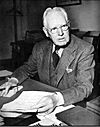 |
James A. Johnston | 1934–48 | James A. Johnston was the first warden of Alcatraz. He was known for being very strict and focused on discipline. He set many rules, including a strict code of silence. He was generally liked by both inmates and guards. He worked to improve prison conditions. |
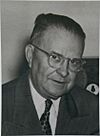 |
Edwin B. Swope | 1948–55 | Edwin B. Swope was the second warden. He was also a strict disciplinarian. However, he was considered the least popular warden among both his officers and the inmates. |
 |
Paul J. Madigan | 1955–61 |
Paul J. Madigan was the third warden. He was the only warden who started as a Correctional Officer and worked his way up. He was known for being more understanding and less strict than his predecessors. He was well-liked by the prison staff. |
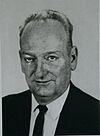 |
Olin G. Blackwell | 1961–63 |
Olin G. Blackwell was the fourth and final warden of Alcatraz. He served during a difficult time when the prison was closing. He was considered the least strict warden. He was on vacation during the famous 1962 escape attempt. |
Life Inside the Cells
About 1,576 prisoners were held at Alcatraz during its time as a federal prison. The cells were designed so that none touched an outside wall. They were typically 9 feet by 5 feet and 7 feet high. Each cell had a bed, a desk, a washbasin, and a toilet. There was an air vent covered by a metal grille at the back of each cell. Prisoners had no privacy when using the toilet, and the toilets smelled bad because they used salt water. Hot water taps were not added until the early 1960s.
The prison had very strict rules for both prisoners and guards. Inmates were given food, clothing, shelter, and medical care. Anything else was a privilege. Prisoners wore blue shirts and grey pants. They had to keep their cells tidy. Any forbidden items like money or tools could lead to punishment. Prisoners had to shave three times a week. Black inmates were kept separate from others.
Toilet paper, soap, and cleaning supplies were given out twice a week. Prisoners could ask for hot water and a mop to clean their cells. The prison bars, windows, and floors were cleaned daily. In the early years, a strict silence rule was enforced. But by the 1950s, talking quietly was allowed in the cellhouse and dining hall.
Prisoners woke up at 6:30 a.m. and went to breakfast at 6:55 a.m. After breakfast, they cleaned their cells. Work started at 7:30 a.m. for those with privileges. Prisoners had to accept any job they were given. They could not have money, but their earnings went into a special account for when they left prison. Smoking was allowed in workplaces if it was safe.
Lunch was at 11:20 a.m., followed by a 30-minute rest. Work continued until 4:15 p.m. Dinner was at 4:25 p.m. Prisoners were locked in their cells for the night at 4:50 p.m. Lights went off at 9:30 p.m. Many prisoners felt their time at Alcatraz was like "hell."
The Alcatraz Library was at the end of D-Block. Every inmate received a library card and a book catalog. They could order books, which were delivered to their cells. The library had 10,000 to 15,000 books. Inmates could have up to three books, plus textbooks, a Bible, and a dictionary. They could subscribe to magazines, but crime-related pages were removed. Newspapers were not allowed. The library censored books and magazines to ensure they were appropriate.
Prisoners read 75 to 100 books a year on average. In the evenings, they often read or practiced musical instruments like the guitar or accordion. A prison band sometimes practiced in the dining room.
Prison Corridors
The corridors in Alcatraz's cellhouse were named after famous American streets. "Michigan Avenue" was next to A-Block. "Broadway" was the main corridor where inmates gathered before meals. It separated B-Block and C-Block. Prisoners along Broadway had the least privacy.
The corridor between C-Block and the library was called "Park Avenue." The corridor in D-Block was named "Sunset Strip." Gun galleries were at the end of each block.
A-Block
A-Block was never updated and kept its old-style bars and spiral staircases from the military prison. No inmates were kept there permanently as federal prisoners. It was mainly used for storage later on. A law library was set up there for inmates to type legal documents.
A small barber's shop was at the end of A-Block, where inmates got monthly haircuts.
B-Block
Most new inmates at Alcatraz were first assigned to the second tier of B-Block. They were in "quarantine" for their first three months and could not have visitors. After 90 days, they were allowed one visitor a month. Letters were checked by staff for secret messages. Frank Morris and the Anglin brothers escaped by entering a utility corridor behind B-Block.
D-Block
D-Block was known as a "treatment block" for the most difficult inmates. It had different levels of punishment, including isolation and solitary confinement. Prisoners usually spent 3 to 19 days in solitary. They ate in their cells, could not work, and showered only twice a week. After an escape attempt in 1939, security in D-Block was made even tighter. The "Birdman of Alcatraz" lived in cell 42 in D-Block in solitary confinement for six years.
The harshest cells for punishment were at the end of D-Block, known as "The Hole." These cells had only a sink and a toilet. The worst cell, nicknamed "The Oriental," had only a hole in the floor for a toilet. Prisoners there were often kept naked for days. Guards controlled when the toilet in this cell was flushed. After punishment in "The Hole," prisoners would return to their cells with reduced privileges.
Dining Hall
The Alcatraz Dining Hall, also called the Mess Hall, is where prisoners and staff ate. It was a long wing on the west end of the Main Cellhouse. It connected to the cell blocks by a corridor called "Times Square." This wing included the dining hall and the kitchen. Above it, on the second floor, were the hospital and an auditorium where movies were shown on weekends.
Dining in the hall followed strict rules. A whistle system told different groups of men when to move. Prisoners woke at 6:30 a.m. and had breakfast at 6:55 a.m. A menu from March 21, 1963, shows breakfast included cereal, eggs, milk, fruit, and toast. Lunch was at 11:20 a.m., followed by a rest. Dinner was at 4:25 p.m., and prisoners were locked in their cells by 4:50 p.m. Inmates could eat as much as they wanted in 20 minutes, but they could not waste food.
Each dining table originally held six men, but later smaller tables for four were used. All prison residents, including guards, ate together. The food at Alcatraz was said to be the best in the U.S. prison system.
Recreation Yard
The Recreation Yard was where inmates exercised and spent time outdoors. It was located opposite the dining hall, facing the mainland. Guard Tower #3 was nearby. A gun gallery was on one of the dining hall's outer walls.
In 1936, the dirt yard was paved. The yard was part of the violent 1946 escape attempt. Inmates were allowed in the yard on Saturdays, Sundays, and holidays for up to 5 hours. Prisoners who worked seven days a week got short breaks in the yard during weekdays. Bad behavior could cause prisoners to lose their yard privileges.
Inmates could play games like baseball and softball, as well as intellectual games like chess. Because the yard was small, a section of the wall behind first base on the baseball field was padded. Prisoners were given gloves, bats, and balls, but no uniforms. Many inmates used their time in the yard to talk with each other, as it was one of their few chances for longer conversations.
Other Buildings on Alcatraz
Warden's House
The Warden's House was at the northeast end of the Main Cellblock, next to the Alcatraz Island Lighthouse. This large, 15-room house was built around 1921.
From 1934 to 1963, the four wardens of Alcatraz lived here. It was a luxurious home, very different from the prison next door. The wardens often hosted parties here. The house had tall windows with great views of San Francisco Bay. Today, the house is a ruin. It burned down during the Native American occupation of Alcatraz in 1970.
Building 64
Building 64 was the first building built on Alcatraz Island for military officers and their families. It was located near the dock on the southeastern side. This three-story apartment building was constructed in 1905. It served as military barracks until 1933.
Social Hall
The Social Hall, also called the Officers' Club, was a social place for prison workers and their families. It was located on the northwestern side of the island. This club was a place for people to relax after the prisoners were locked up. It also burned down during the Native American occupation in 1970, and only its shell remains.
The club had a small bar, a library, a large dining and dance floor, and games like billiards and ping pong. It even had a two-lane bowling alley. It was the center of social life on the island, hosting dinners, bingo, and movies every Sunday night.
Power House
The Power House is on the northwest coast of Alcatraz Island. It was built in 1939 as part of a big modernization project. Its white smokestack and the lighthouse made the island look like a ship. A warning sign in front of it told people to stay away.
From 1939 to 1963, it provided power to the prison and other buildings. The powerhouse had a guard station with weapons to protect it.
Alcatraz Water Tower
The water tower is on the northwestern side of the island. Alcatraz had no natural water supply, so water had to be brought from the mainland by boat. The water tower was built in 1940–41 to store most of the island's fresh water.
It is the tallest building on the island, standing 94 feet (29 m) high. It could hold 250,000 gallons (946 kL) of fresh water. This water was used for drinking, fighting fires, and the island's laundry.
Model Industries Building
The Model Industries Building is a three or four-story building on the northwest corner of Alcatraz Island. It was originally built by the U.S. military as a laundry building. When Alcatraz became a federal prison, it held workshops where inmates worked.
In 1935, a severe storm caused a landslide that shifted the building. The warden suggested building a seawall to protect it. A guard tower and a catwalk were added to the roof in 1936. The building was made more secure with bars from old cells. It stopped being a laundry in 1939. Today, the building is heavily rusted from years of salty air.
New Industries Building
The New Industries Building was built in 1939. It was part of a $1.1 million modernization project.
The ground floor of this two-story, 306-foot-long building had a clothing factory, a dry cleaning plant, a furniture plant, and a brush factory. Prisoners worked here for a small wage. This money went into a "Prisoner's Trust Fund" and was given to them when they left Alcatraz. They made items like gloves, mats, and army uniforms. The entire upper floor was a laundry room, which was the largest in San Francisco at the time.
Famous Inmates
| Image | Inmate | Term | Summary |
|---|---|---|---|
| Arthur R. Barker ("Doc") | 1935–39 | Arthur Barker was part of the Barker-Karpis gang. He was sent to Alcatraz for kidnapping. He was killed by guards during an escape attempt in 1939. | |
 |
Alphonse "Al" Gabriel Capone ("Scarface") | 1934–39 | When Al Capone arrived at Alcatraz, prison officials made it clear he would not get special treatment. He tried to get favors from the warden but failed. He worked at various jobs in the prison. Capone was involved in fights with other prisoners. He left Alcatraz in 1938 due to poor health and died in 1947. |
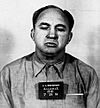 |
Meyer Harris Cohen ("Mickey") | 1961–63 | Mickey Cohen was involved in gambling rackets. He was sent to Alcatraz for tax evasion. He was transferred to another prison shortly before Alcatraz closed. |
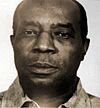 |
Ellsworth Raymond Johnson ("Bumpy") | 1954–63 | "Bumpy" Johnson was a famous African-American gangster from Harlem. He was imprisoned at Alcatraz from 1954 to 1963. He was thought to have been involved in the 1962 escape attempt. |
 |
Alvin Francis Karpavicz ("Creepy Karpis") | 1936–62 | Alvin Karpis was a Canadian criminal and a leader of the Ma Barker-Karpis gang. He was one of only four "Public Enemy #1" criminals named by the FBI. He spent 26 years in Alcatraz, the longest of any federal prisoner there. He was deported to Canada in 1969. |
 |
George Kelly Barnes ("Machine Gun Kelly") | 1934–51 | "Machine Gun Kelly" arrived at Alcatraz in 1934. He often boasted about crimes he didn't commit. Despite this, Warden Johnston considered him a good inmate. He was transferred from Alcatraz in 1951. |
| Rafael Cancel Miranda | 1954–60 | In 1954, Rafael Cancel Miranda was sent to Alcatraz. He was a model prisoner, working in the brush factory and serving as an altar boy. He made friends with other prisoners. His family visited him, but he could only talk to his wife through glass using a phone. They had to speak English. He was transferred in 1960. | |
 |
Robert Franklin Stroud ("Birdman of Alcatraz") | 1942–59 | Robert Stroud was known as the Birdman of Alcatraz. He was transferred to Alcatraz in 1942. He had killed a guard in another prison. Stroud taught himself about birds and wrote books on bird diseases. He spent most of his time in Alcatraz in solitary confinement in D-Block. He was not allowed to keep birds at Alcatraz, unlike in his previous prison. He died in 1963. |
Legends and Myths
The earliest known people on Alcatraz Island were the Ohlone Native Americans. In Miwok stories, evil spirits were said to live on the island. In popular culture, Alcatraz is often listed as one of the most "haunted" places in California.
See also
 In Spanish: Prisión Federal de Alcatraz para niños
In Spanish: Prisión Federal de Alcatraz para niños
- ADX Florence – nicknamed "Alcatraz of the Rockies"
- Louisiana State Penitentiary – nicknamed "Alcatraz of the South"



